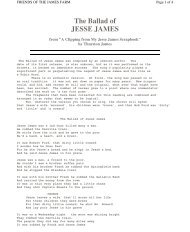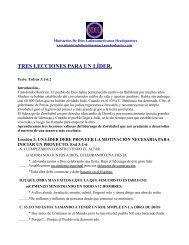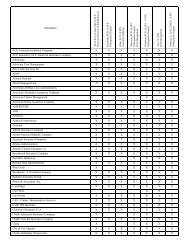icr graduates — a cause for celebration
icr graduates — a cause for celebration
icr graduates — a cause for celebration
You also want an ePaper? Increase the reach of your titles
YUMPU automatically turns print PDFs into web optimized ePapers that Google loves.
long-period trend of F S constructed by Vieira and Solanki 4 with the<br />
same period of the estimated mean northern hemispheric temperature<br />
anomaly, ΔT N, constructed by Mann et al 5 and the detrended winter<br />
CET, δT DJF, constructed by Lockwood et al 1 and Parker et al. 3 Note that<br />
F S in Figure 1 (a) is zero in 1650 A.D. <strong>for</strong> a period of about 50 years,<br />
during which time the estimated northern hemispheric temperature,<br />
ΔT N, is about 0.25 o C below the long-term mean and the estimated CET<br />
anomaly, δT DJF , averages a relative low temperature of about 3 o C. This<br />
was during the Little Ice Age in Europe. From about 1700 A.D., F S rose<br />
to the highest solar activity on record. Just prior to 2000 A.D., it appears<br />
to have begun a significant decline. ΔT N also appears to have reached a<br />
maximum just after 2000 A.D. and is now on the decline. δT DJF appears<br />
to have begun a decline in the late 1990s and is declining even more<br />
steeply. There are various lag times involved in cosmic and atmospheric<br />
processes, so it’s not surprising that the changes in these variables aren’t<br />
aligned exactly. But it seems clear from this data that the level of solar<br />
activity has a direct correlation with temperatures both in the northern<br />
hemisphere in general and in central England in particular.<br />
Figure 1. Trends in solar activity and temperature since the mid-17th<br />
century. 1 (a) Annual mean open solar flux, F S. The mauve line is a<br />
model based on observed sunspot numbers. 4 The black line after 1905<br />
A.D. is derived from ground-based geomagnetic data. The dots are annual<br />
means of interplanetary satellite data. (b) Estimated mean northern<br />
hemispheric temperature anomaly, ΔT N. The black line shows the Had-<br />
CRUT3v compilation of observations. 6 The mauve line shows the median<br />
of an ensemble of 11 reconstructions (individually intercalibrated<br />
with the HadCRUT3v northern hemispheric data over the interval 1850-<br />
1950 A.D.) based on tree ring and other proxy data. The decile range is<br />
given by the gray shaded area. (c) Detrended winter CET anomaly, δT DJF.<br />
D, J, F are abbreviations <strong>for</strong> the winter months December, January, and<br />
February. The curve is obtained by subtracting the best-fit variation of<br />
ΔT N from the mean monthly CET. The dots are <strong>for</strong> years with δT DJF<br />
< 1 o C (the dashed horizontal line). Data <strong>for</strong> the winter of 2009/2010 A.D.<br />
are provisional. 7<br />
In their interpretation of the results, Lockwood et al 1 leave the door<br />
open to an interaction between solar activity and clouds and, thereby,<br />
changes in surface heating in accordance with galactic cosmic radiation<br />
changes as suggested by Svensmark. 8 However, they appear to prefer an<br />
interpretation that solar activity is more likely to <strong>cause</strong> changes in upper<br />
atmospheric airflow patterns. They suggest that such effects might <strong>cause</strong><br />
weather patterns to be blocked over the Atlantic, leading to climate<br />
changes in Europe. However, they offer little support <strong>for</strong> this view. Why<br />
would changes in solar activity interact with jet stream dynamics? They<br />
don’t even hint at a possible physical mechanism. If they were serious<br />
about this suggestion, they would at least offer a potential process by which<br />
surface temperatures can change. Examples of possible mechanisms<br />
might be: 1) upper atmospheric pressure and wind could change due to<br />
fluctuations in the radiation balance, or 2) jet stream winds could change<br />
due to charged cloud particle interactions with electromagnetic fields.<br />
Another difficulty I have with their preference <strong>for</strong> solar-driven<br />
upper atmospheric flow patterns is that it diminishes the evidence <strong>for</strong><br />
early signs of global cooling in regions beyond England. If the changes<br />
in solar activity are global, I would expect global consequences. Yet, they<br />
are careful to restrict their application of their data to England, possibly<br />
Europe, but probably not to the entire globe. This caution is appropriate<br />
be<strong>cause</strong> of the small scale of the CET record. However, the likely global<br />
nature of the solar activity revealed by the open magnetic flux variable,<br />
F S, would tend to argue <strong>for</strong> a global effect on surface temperature.<br />
Lockwood et al have provided new evidence that global warming<br />
may have peaked and has begun to wane. However, until they offer a<br />
better model <strong>for</strong> how solar activity interacts with earth’s atmosphere<br />
and changes surface temperatures, I prefer Svensmark’s explanation of<br />
less cloud <strong>for</strong>mation when the sun is active and more solar radiation<br />
is available to heat the earth. In any regard, not only does the evidence<br />
contradict the current political and scientific trend of blaming manmade<br />
emissions <strong>for</strong> global warming<strong>—</strong>it appears that long-term global<br />
warming may not even be occurring at all. 9<br />
References<br />
1. Lockwood, M. et al. 2010. Are cold winters in Europe associated with solar activity? Environmental<br />
Research Letters. 5 (2): 024001.<br />
2. Manley, G. 1974. Central England temperatures: Monthly means 1659 to 1973. Quarterly Journal<br />
of the Royal Meteorological Society. 100: 389-405.<br />
3. Parker, D. E., T. P. Legg and C. K. Folland. 1992. A New Daily Central England Temperature<br />
Series, 1772-1991. International Journal of Climatology. 12: 317-342.<br />
4. Vieira, L. E. A. and S. K. Solanki. 2009. Evolution of the solar magnetic flux on time scales of years<br />
to millennia. Astronomy and Astrophysics. 509: A100.<br />
5. Mann, M. E. et al. 2008. Proxy-based reconstruction of hemispheric and global surface temperature<br />
variations over the past two millennia. Proceedings of the National Academy of Sciences. 105<br />
(36): 13252-13257.<br />
6. Brohan, P. et al. 2006. Uncertainty estimates in regional and global observed temperature changes:<br />
A new dataset from 1850. Journal of Geophysical Research. 111: D12106.<br />
7. Figure 1 is adapted from Figure 2 in Lockwood et al, Are cold winters in Europe associated with<br />
solar activity?<br />
8. Svensmark, H. et al. 2007. Experimental evidence <strong>for</strong> the role<br />
of ions in particle nucleation under atmospheric conditions.<br />
Proceedings of the Royal Society A. 463 (2078): 385-396.<br />
9. For more in<strong>for</strong>mation, see Vardiman, L. 2008. Does Carbon<br />
Dioxide Drive Global Warming? Acts & Facts. 37 (10): 10;<br />
Vardiman, L. 2008. A New Theory of Climate Change. Acts &<br />
Facts. 37 (11): 10; Vardiman, L. 2009. Will Solar Inactivity Lead<br />
to Global Cooling? Acts & Facts. 38 (7): 12; Vardiman, L. 2010.<br />
Climategate: Begging the Question. Acts & Facts. 39 (5): 12-13.<br />
Dr. Vardiman is Chair of the Department of Astro/Geophysics.<br />
JULY 2010 • ACTS&FACTS<br />
13
















